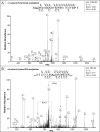Regulation of acetylation restores proteolytic function of diseased myocardium in mouse and human
- PMID: 24037710
- PMCID: PMC3861724
- DOI: 10.1074/mcp.M113.028332
Regulation of acetylation restores proteolytic function of diseased myocardium in mouse and human
Abstract
Proteasome complexes play essential roles in maintaining cellular protein homeostasis and serve fundamental roles in cardiac function under normal and pathological conditions. A functional detriment in proteasomal activities has been recognized as a major contributor to the progression of cardiovascular diseases. Therefore, approaches to restore proteolytic function within the setting of the diseased myocardium would be of great clinical significance. In this study, we discovered that the cardiac proteasomal activity could be regulated by acetylation. Histone deacetylase (HDAC) inhibitors (suberoylanilide hydroxamic acid and sodium valproate) enhanced the acetylation of 20S proteasome subunits in the myocardium and led to an elevation of proteolytic capacity. This regulatory paradigm was present in both healthy and acutely ischemia/reperfusion (I/R) injured murine hearts, and HDAC inhibition in vitro restored proteolytic capacities to baseline sham levels in injured hearts. This mechanism of regulation was also viable in failing human myocardium. With 20S proteasomal complexes purified from murine myocardium treated with HDAC inhibitors in vivo, we confirmed that acetylation of 20S subunits directly, at least in part, presents a molecular explanation for the improvement in function. Furthermore, using high-resolution LC-MS/MS, we unraveled the first cardiac 20S acetylome, which identified the acetylation of nine N-termini and seven internal lysine residues. Acetylation on four lysine residues and four N-termini on cardiac proteasomes were novel discoveries of this study. In addition, the acetylation of five lysine residues was inducible via HDAC inhibition, which correlated with the enhancement of 20S proteasomal activity. Taken as a whole, our investigation unveiled a novel mechanism of proteasomal function regulation in vivo and established a new strategy for the potential rescue of compromised proteolytic function in the failing heart using HDAC inhibitors.
Figures



Similar articles
-
Acetylation: a lysine modification with neuroprotective effects in ischemic retinal degeneration.Exp Eye Res. 2014 Oct;127:124-31. doi: 10.1016/j.exer.2014.07.012. Epub 2014 Jul 23. Exp Eye Res. 2014. PMID: 25064603 Free PMC article.
-
Histone deacetylation inhibition in pulmonary hypertension: therapeutic potential of valproic acid and suberoylanilide hydroxamic acid.Circulation. 2012 Jul 24;126(4):455-67. doi: 10.1161/CIRCULATIONAHA.112.103176. Epub 2012 Jun 18. Circulation. 2012. PMID: 22711276 Free PMC article.
-
Selective inhibition of class I but not class IIb histone deacetylases exerts cardiac protection from ischemia reperfusion.J Mol Cell Cardiol. 2014 Jul;72:138-45. doi: 10.1016/j.yjmcc.2014.03.005. Epub 2014 Mar 13. J Mol Cell Cardiol. 2014. PMID: 24632412 Free PMC article.
-
Targeting histone deacetylases: development of vorinostat for the treatment of cancer.Epigenomics. 2010 Jun;2(3):457-65. doi: 10.2217/epi.10.20. Epigenomics. 2010. PMID: 22121904 Review.
-
Targeting cardiac fibroblasts to treat fibrosis of the heart: focus on HDACs.J Mol Cell Cardiol. 2014 May;70:100-7. doi: 10.1016/j.yjmcc.2014.02.015. Epub 2014 Mar 11. J Mol Cell Cardiol. 2014. PMID: 24631770 Free PMC article. Review.
Cited by
-
Proteasomal and lysosomal protein degradation and heart disease.J Mol Cell Cardiol. 2014 Jun;71:16-24. doi: 10.1016/j.yjmcc.2013.11.006. Epub 2013 Nov 14. J Mol Cell Cardiol. 2014. PMID: 24239609 Free PMC article. Review.
-
Acetylation mediates Cx43 reduction caused by electrical stimulation.J Mol Cell Cardiol. 2015 Oct;87:54-64. doi: 10.1016/j.yjmcc.2015.08.001. Epub 2015 Aug 8. J Mol Cell Cardiol. 2015. PMID: 26264759 Free PMC article.
-
Oxidative Post-translational Protein Modifications upon Ischemia/Reperfusion Injury.Antioxidants (Basel). 2024 Jan 16;13(1):106. doi: 10.3390/antiox13010106. Antioxidants (Basel). 2024. PMID: 38247530 Free PMC article.
-
Regulation of metabolism by mitochondrial enzyme acetylation in cardiac ischemia-reperfusion injury.Biochim Biophys Acta Mol Basis Dis. 2020 Jun 1;1866(6):165728. doi: 10.1016/j.bbadis.2020.165728. Epub 2020 Feb 15. Biochim Biophys Acta Mol Basis Dis. 2020. PMID: 32068115 Free PMC article. Review.
-
S-nitrosylation of TRIM72 mends the broken heart: a molecular modifier-mediated cardioprotection.J Mol Cell Cardiol. 2014 Jul;72:292-5. doi: 10.1016/j.yjmcc.2014.04.004. Epub 2014 Apr 13. J Mol Cell Cardiol. 2014. PMID: 24735828 Free PMC article. No abstract available.
References
-
- Scruggs S. B., Ping P., Zong C. (2011) Heterogeneous cardiac proteasomes: mandated by diverse substrates? Physiology 26, 106–114 - PubMed
Publication types
MeSH terms
Substances
Grants and funding
LinkOut - more resources
Full Text Sources
Other Literature Sources
Molecular Biology Databases

